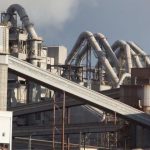Types Of Cement
· Ordinary Portland cement
· OPC33,OPC43 and OPC53 grade
· Rapid hardening cement
· Extra rapid hardening cement
· Sulphate resisting cement
· Portland slag cement
· Quick setting cement
· Low heat cement
· Portland pazzolona cement
· Air entraining cement
· Coloured cement
· White cement
· Hydrophobic cement
· Masonry cement
· expansive cement
· Oil well cement
· Redi set cement
· Concrete sleeper grade cement
· High alumina cement
· Very high strength cement
Chemical Admixtures Of Concrete
Water-reducing admixture / Plasticizers:
These admixtures are used for following purposes:
1. To achieve a higher strength by decreasing the water cement ratio at the same workability as an admixture free mix.
2. To achieve the same workability by decreasing the cement content so as to reduce the heat of hydration in mass concrete.
3. To increase the workability so as to ease placing in accessible locations
4. Water reduction more than 5% but less than 12%
Actions involved:
1. Dispersion:
Surface active agents alter the physic chemical forces at the interface. They are adsorbed on the cement particles, giving them a negative charge which leads to repulsion between the particles. Electrostatic forces are developed causing disintegration and the free water become available for workability.
2. Lubrication:
As these agents are organic by nature, thus they lubricate the mix reducing the friction and increasing the workability.
3. Retardation:
A thin layer is formed over the cement particles protecting them from hydration and increasing the setting time. Most normal plasticizers give some retardation, 30–90 minutes.
Super Plasticizers:
· These are more recent and more effective type of water reducing admixtures also known as high range water reducer.
The commonly used Super Plasticizers are as follows:
Sulphonated melamine formaldehyde condensates (SMF)
Give 16–25%+ water reduction. SMF gives little or no retardation, which makes them very effective at low temperatures or where early strength is most critical.
However, at higher temperatures, they lose workability relatively quickly. SMF generally give a good finish and are colorless, giving no staining in white concrete.
They are therefore often used where appearance is important.
Sulphonated naphthalene formaldehyde condensates (SNF)
Typically give 16–25%+ water reduction. They tend to increase the entrapment of larger, unstable air bubbles. This can improve cohesion but may lead to more surface defects.
Retardation is more than with SMF but will still not normally exceed 90 minutes. SNF is a very cost-effective.
Polycarboxylate ether super plasticizers (PCE)
Typically give 20–35%+ water reduction. They are relatively expensive per liter but are very powerful so a lower dose (or more dilute solution) is normally used.
In general the dosage levels are usually higher than with conventional water reducers, and the possible undesirable side effects are reduced because they do not markedly lower the surface tension of the water.
Accelerators:
An admixture which, when added to concrete, mortar, or grout, increases the rate of hydration of hydraulic cement, shortens the time of set in concrete, or increases the rate of hardening or strength development.
Accelerating admixtures can be divided into groups based on their performance and application:
1. Set Accelerating Admixtures,
Reduce the time for the mix to change from the plastic to the hardened state. Set accelerators have relatively limited use, mainly to produce an early set.
2. Hardening Accelerators,
Which increase the strength at 24 hours by at least 120% at 20ºC and at 5ºC by at least 130% at 48 hours. Hardening accelerators find use where early stripping of shuttering or very early access to pavements is required.
They are often used in combination with a high range water reducer, especially in cold conditions.
Set Retarders:
The function of retarder is to delay or extend the setting time of cement paste in concrete. These are helpful for concrete that has to be transported to long distance, and helpful in placing the concrete at high temperatures.
When water is first added to cement there is a rapid initial hydration reaction, after which there is little formation of further hydrates for typically 2–3 hours.
The exact time depends mainly on the cement type and the temperature. This is called the dormant period when the concrete is plastic and can be placed.
At the end of the dormant period, the hydration rate increases and a lot of calcium silicate hydrate and calcium hydroxide is formed relatively quickly. This corresponds to the setting time of the concrete.
Retarding admixtures delay the end of the dormant period and the start of setting and hardening. This is useful when used with plasticizers to give workability retention. Used on their own, retarders allow later vibration of the concrete to prevent the formation of cold joints between layers of concrete placed with a significant delay between them.
The mechanism of set retards is based on absorption. The large admixture anions and molecules are absorbed on the surface of cement particles, which hinders further reactions between cement and water i.e. retards setting.
Air Entrained Admixtures:
An addition for hydraulic cement or an admixture for concrete or mortar which causes air, usually in small quantity, to be incorporated in the form of minute bubbles in the concrete or mortar during mixing, usually to increase its workability and frost resistance.
Air-entraining admixtures are surfactants that change the surface tension of the water. Traditionally, they were based on fatty acid salts or vinsol resin but these have largely been replaced by synthetic surfactants or blends of surfactants to give improved stability and void characteristics to the entrained air.
Air entrainment is used to produce a number of effects in both the plastic and the hardened concrete. These include:
· Resistance to freeze–thaw action in the hardened concrete.
· Increased cohesion, reducing the tendency to bleed and segregation in the plastic concrete.
· Compaction of low workability mixes including semi-dry concrete.
· Stability of extruded concrete.



Comments are closed